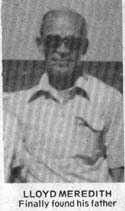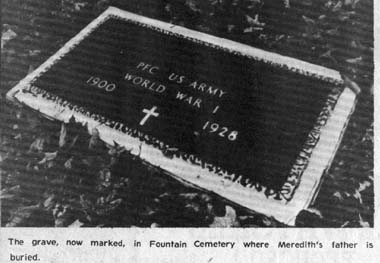November 8, 1979


Picture #1 (missing) – Meredith’s father (left) and great uncle who helped raise him.
Picture #2 – Lloyd Meredith – Finally found his father
Picture #3 – The grave now marked, in Fountain Cemetery where Meredith’s father is buried.
You have read on many other occasions stories about the search which people conducted to find long-lost relatives, and the joy of locating them.
My story today is one of those, but unusual in many respects, since it involves the search by a man for his dead father’s grave, and the details about his death, after separation from him since early childhood.
The story ended earlier this year, here in Fostoria, thanks to the available records of various organizations, including the microfilmed copies of The Fostoria Daily Review, on file at Kaubisch Library; and the effective help of Pat Bowman at the library in spotting the microfilmed item that produced vital information.
Starting at the beginning, Lloyd R. Meredith of Savannah, Tenn., arrived in Fostoria in December, 1978, to make an all-out effort to determine when his father had dies, and how; and where he was buried.
When Meredith was a child, an aunt now deceased, furnished a hint that his father died as the result of a violent incident, and she thought the town was Fostoria. That’s why Meredith came here.
MEREDITH’S LIFE STORY
The story of Meredith’s early life is told by him: “My father deposited both my brother and me with the Ashtabula Community Welfare Association. For some reason we were immediately separated, with Roger going to the orphanage and me to a private home. After a short time I was taken to Perry, Ohio, to live with my aunt (who never married) and great uncle (bachelor)”.
“From that time until I was 16, I was shuttled between them and the Lake County Child Welfare Society, living in at least eight different foster homes”.
“My brother continued to live at the Ashtabula Orphanage with a brief change to Ohio Veterans Children’s Home at Xenia”.
“My mother found me at Perry living on a farm with very fine people where I had been placed by the Welfare. I joined her and my new stepfather in Philadelphia, Pa., as soon as proper arrangements could me made”.
“I had not seen my brother in all these years and was so young when we were separated that I did not remember him, but based on conversations I had heard from my aunt and great uncle when i was young, I was able to set my parents on his trail and we were all reunited within a months time in Philadelphia”.
Meredith figured that his father may have died in the early 1920’s, perhaps 1924. When he arrived in Fostoria he first contacted The Review Times, and they referred him to the library. His first search of the files there disclosed nothing. Pat Bowman, referred Meredith to me, thinking that perhaps my search of old files might be fruitful in his behalf.
I talked with various Fostorians about the matter, thinking they might remember a violent death at that period of time. Earlier inquiry had led Meredith to believe that possibly his father had been shot and died as the result of a labor strike here, or perhaps during a breaking and entering incident.
FACTS COME TO LIGHT
Sometime later, Pat Bowman, while searching the files for other data, came across a story involving the shooting death of a man at the time of an alleged breaking and entering. The incident took place at a South Union Street home, in a neighborhood where there had been attempts to break in.
The published story at that time revealed that the man of the house where the shooting occurred had been watching the prowler attempt to remove a window screen. He commanded the man to stand still and not move, but he ran. It was then that he shot him, the gun’s blast hitting the man in the stomach.
The prowler was removed by ambulance to Fostoria City Hospital, where he gave his name as Eugene McNeal, but refused to provide information about his family or residence. However, shortly before he died, he disclosed that he and his wife had separated, and he knew not where she was. Also, that he had placed their two small children in an orphanage in Ashtabula, Ohio. He said he was a World War I veteran, and had been born in Jacksonville, Fla.
McNeal’s finger prints were taken and sent to the War Department for possible identification. The message came back that the shooting victim was identified but not “McNeal” as he had indicated. Since no family members were located, he was buried in an unmarked grave in Fountain Cemetery; and the details of the shooting incident were conveyed to the government.
VICTIM WORKED LOCALLY
After the burial, it was learned that the victim had been employed at the Auto-Lite; also that he had worked at several other places here, always known as “McNeal”. He had talked to friends about his two children in the orphanage.
At about the same time that Mrs. Bowman discovered the data and sent information to Meredith, he had been able to get information from the Ohio Veterans Children’s Home at Xenia, verifying that the man in question had died in Fostoria May 28, 1928, but they had no information about the cause of death.
Now, with the two pieces of information, Meredith’s quest for the truth about how his father died, and where he was buried became fully known.
Meredith’s father (name not given for obvious reasons) enlisted in the Army in 1918, in McKee’s Rock, Pa. He was a member of Company H, 320th Infantry until 1919.
He then served in the 285 MP Company until Oct. 18, 1919. He served overseas from May 18, 1918 until Nov. 1, 1919, when he was honorably discharged. He was born in Jacksonville, Fla. in 1900, making his age at death 28.
When he returned from overseas he brought with him a French bride, whom he had married on June 27, 1919 at Brest, France. The couple settled in Cleveland, and had two sons, Roger, born in 1920, and Lloyd in 1921. Shortly after that he disappeared and the brothers were placed in the Ashtabula orphanage. His wife never knew the details of her husband’s death until her son Lloyd unraveled the mystery. She is still living, and remarried. The other son and brother is also living.
When Lloyd Meredith came out of the Air Force in 1945, he went to work for Quaker Oats for six years, during which he was promoted to district manager. Then he spent seven years with Moore Business Forms as a district manager. In recent years he has been an independent sales representative for advertising specialties, business printing etc.
FAMILY ROOTS REVEALED
Meredith’s search for information about his father’s death led him into genealogy, to learn what he could about his father’s ancestors. The search has resulted in stacks of correspondence and 6,800 miles of travel all of which has netted him an informative family history.
Recently he received a copy of a book, published by an eighth cousin whom he never knew. The book reveals 2,247 individuals of the family from the original immigrant in 1636 to Duxbury, Mass. They were the first to settle in Wayne Twp., Ashtabula County, in 1803. All this is revealed in another book, “Pioneers in the Western Reserve”.
Thanks to accurate records genealogy data and persistence to gather all of those facts, Meredith at age 58 is happy that at last his father’s grave is properly marked and he now knows much more about his family.
On one of Meredith’s trips to Fostoria, he contacted the man, still living, who shot his father. His visit was with no malice, only that they could meet and discuss the matter. The man never intended to shoot to kill. He thought he would hit his legs. As far as this writer is concerned the man remains anonymous.